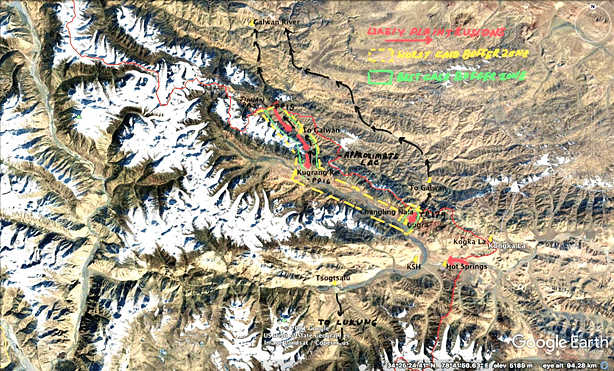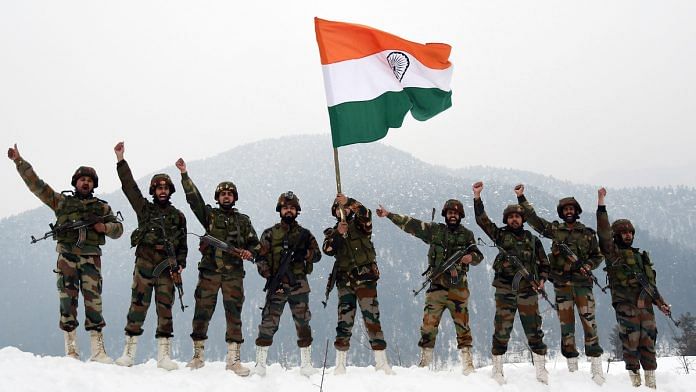On 6 August, the Ministry of Defence announced via a press release that as an outcome of the 12th Round of Corps Commander level talks on 31 July, disengagement has been carried out in the area of Gogra.
As per the agreement, “both sides have ceased forward deployments in this area in a phased, coordinated and verified manner. The disengagement process was carried out over two days i.e. 04 and 05 August 2021. The troops on both sides are now in their respective permanent bases. All temporary structures and other allied infrastructure created in the area by both sides have been dismantled and mutually verified. The landform in the area has been restored by both sides to pre-stand off period.”
Missing was the fanfare, triumphant drum beating and live video coverage that followed the disengagement agreement related to the north and south banks of Pangong Tso announced on 11 February 2021. The reasons are not hard to guess. Chastened by the adverse criticism of “loss of territory and patrolling rights” from Finger 4 to Finger 8 north of Pangong Tso, and giving up the leverage of Kailash Range heights, the Narendra Modi government has reverted back to its policy of obfuscation. This cryptic press release hides more than it conveys. China’s silence on the issue reeks of smugness. It is also indicative of an evolving political understanding, albeit on China’s terms.
The Modi government’s statement indirectly hints at the status quo ante April 2020 as having been restored in the area of Gogra. I carry out a reality check of the likely price we have paid in terms of buffer zones, loss of patrolling rights and border infrastructure development.
Also Read: To deal with China on LAC, India must downsize and restructure the armed forces
Strategic importance of Chang Chenmo Sector
In the Chang Chenmo Sector — Gogra, Hot Springs and Kongka La — the 1959 Claim Line and the Line of Actual Control (LAC) coincide. It was in Kongka La on 21 October 1959 where a CRPF patrol of 20 personnel was ambushed by the People’s Liberation Army (PLA). Ten CRPF Jawans were killed and 7 were taken prisoners of war. In the 1962 India-China war, China had captured this area but after the war, it unilaterally withdrew up to the 1959 Claim Line.

The strategic importance of this area is due to the fact that from here three axes/approaches lead to Aksai Chin. One axis runs east from Kongka La to Lanak La through which the Tibet-Xinjiang Highway 219 passes. Two axes emanate to the north from the Kugrang River via Changlung Nala (PP 17 and 17A) and 30 km upstream via Jianan Pass (PP 15 and 16) towards the upper reaches of the Galwan River. Nearly 70-80 km of the Galwan River Valley can be cut off using these routes. In 1962, we took the route via Changlung Nala to Samzungling to set up the Galwan Post.
Over the last decade, India has been aggressively developing roads in this area up to the LAC. The Chinese perceived the development of these roads as a potential threat to Aksai Chin. To ward off the threat, the Chinese intruded across the 1959 Claim Line via Changlung Nala and via Jianan Pass to the upper reaches of the Kugrang River to deny us access to the Kugrang River Valley beyond Gogra and thereby the northern approaches to Galwan River. Similarly, to deny us the eastern approach, the PLA intruded upon the Kongka La and Hot Springs area (wrongly marked as Gogra on Google Maps).
The intrusion, in terms of distance, was only 3 km in Changlung Nala and 4 km in the area of PP 15 and PP 16, and approximately a similar distance in the area of Hot Springs. However, due to the terrain configuration, the access to 30-35 km long and 4-5 km wide Kugrang River Valley, and to Kongka La, was denied to us.
Also Read: India must more cleverly do to China what Pakistan did to us. But don’t turn LAC into LoC
Reality check
The military aim of China was to prevent the development of border roads and infrastructure that could pose a potential threat to Aksai Chin and Galwan River Valley.
We had no scope for any counter-action in this area to gain leverage due to the 100-km-long tenuous road linking this area to Lukung. In the event of any escalation, the entire Chang Chenmo Sector becomes defensively untenable as the road leading to it can be cut off at Tsogtsalu/Marsimik La/Phobrang. A Chinese offensive in this area in conjunction with an offensive from north of Pangong Tso will result in the loss of the entire territory of north and northeast of Pangong Tso.
Keeping in view its military aims and our terrain compulsions, there is no way China would have agreed to restore the status quo ante April 2020 without imposing its terms.
As per my assessment, in the worst-case, we have agreed to a de facto buffer zone in the entire Kugrang River Valley and the routes leading north to LAC. As a best-case, two separate buffer zones could have been negotiated north of the Kugrang River along the two routes beyond PPs 16 and 17 up to the LAC. In either case, the buffer zones are entirely in areas that were under our control and which we actively patrolled up to April 2020.
So far, no agreement has been reached in the Hot Springs and Depsang Plains. A buffer zone east of Hot Springs up to Kongka La and east of the Bottleneck up to PP,10,11,12 and 13, are likely to be acceptable to the Chinese.
I reiterate what I have written many times before: until we bridge the huge differential in Comprehensive National Power vis-a-vis China, particularly with respect to the economic and military factors, we cannot challenge it. We require two to three decades of sustained economic development to raise our GDP to the level at which China is today. Military budget and reforms/modernisation are contingent upon the economy. Hence, the Modi government has adopted the correct strategy — swallow the bitter pill of buffer zones to diffuse the situation along the LAC and bide our time to challenge China when we are ready to do so.
It would be prudent to explain the strategic compulsions to the nation rather than to obfuscate and be in denial. Nothing is worse than a bluff in matters military, being called by a stronger adversary, as China did in April-May 2020.
Lt Gen H S Panag PVSM, AVSM (R) served in the Indian Army for 40 years. He was GOC in C Northern Command and Central Command. Post retirement, he was Member of Armed Forces Tribunal. Views are personal.
(Edited by Srinjoy Dey)



